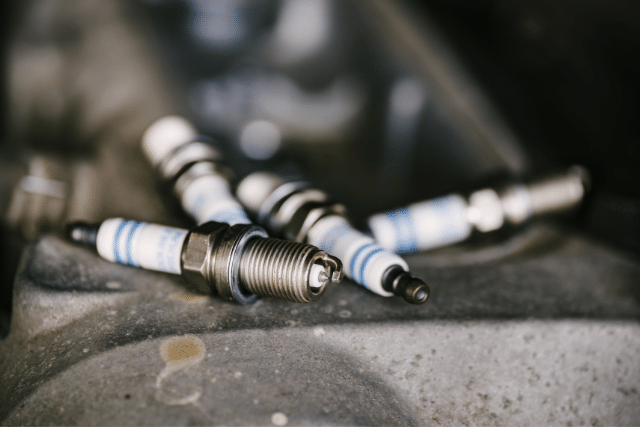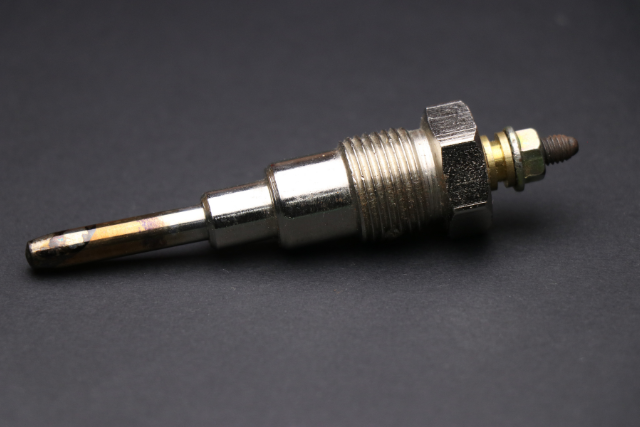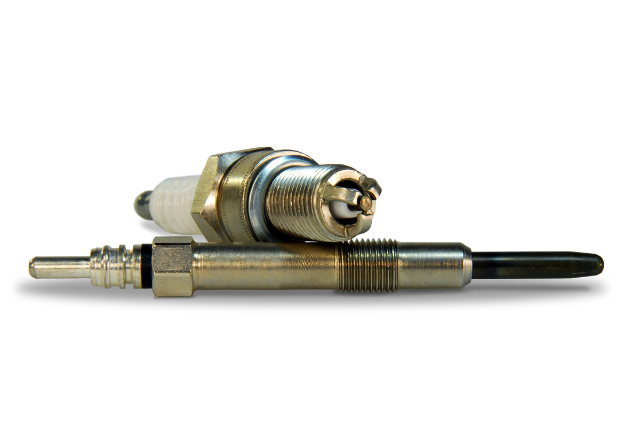Spark plugs and glow plugs sound the same (plugs plugs). They even look similar. But they are completely different components with different functions.
One produces sparks and the other glows (I know I am Mr.Obvious).
So, what’s the difference between a spark plug and a glow plug? Spark plugs are used in gasoline engines to ignite the fuel mixture. Glow plugs, on the other hand, are used in diesel engines to preheat the engine.
That’s the gist. And honestly, if you know this much you are going to be fine. But if you are interested in more of the juice, let’s dig in.
Spark plugs
Spark plugs are the components used to ignite the fuel mixture in gasoline engines.

The spark plug delivers the spark continuously to keep the engine running.
If the spark plug fails to ignite, the engine starts knocking and even stops altogether. That’s why, the spark plugs often need to be replaced because of their short life.
What does a spark plug do?
The function of a spark plug is to ignite the fuel mixture in a gasoline engine.
How does it do?
The spark plug, with the help of high voltage electricity provided to it, generates a spark. A high-voltage one of course.

The spark is produced right when the piston compresses the air-fuel mixture within the engine combustion chamber. Right towards the end of the compression stroke.
This spark ignites the air-fuel mixture in the engine combustion chamber.
The result?
The air-fuel mixture combusts and provides energy. Which the engine uses.
So, in short, the spark plug is used to ignite the fuel mixture in the engine. Not just any engine though. Only gasoline engines.
Why? We will come to that later.
What you need to know for now is – spark plug ignition is the mode of ignition in a gasoline engine.
Spark plug structure
Now that we have a good idea of what a spark plug does, let’s dig into its parts.
In brief:
The main components of a spark plug include – the terminal, insulator, shell, threads, and the two electrodes (center and ground).
The terminal acts as the connector to pass the high-voltage electricity to the center electrode. Whereas the insulator insulates the terminal and the shaft that connects the terminal and the central electrode.
The shell and threads help in fitting the spark plug tightly on the cylinder head.
The center electrode is connected to the terminal through a central shaft. And the ground electrode acts as the grounding for the high volt electricity in the spark plug.
The center electrode tip carrying the high voltage generates the spark in the small gap between this electrode and the ground electrode.
Used in
Spark plugs are used in gasoline engines for ignition.
Gasoline engines have a comparatively lower compression ratio that is insufficient to cause combustion.
That’s why, spark plugs are required.
Spark plugs are used in all gasoline engines to ignite the fuel mixture.
Glow plugs
Glow plugs are electrical heating components fitted in diesel engines.

The glow plugs come in handy during cold starts for diesel engines. The presence of glow plugs ensures dependable starts for diesel engines regardless of the weather.
How do they do it?
Let’s get to it.
What does a glow plug do?
The glow plug with its electrical heating heats up the engine combustion chamber. Facilitating the engine to function smoothly in different weather conditions.

Diesel engines, unlike gasoline engines, use high compression to ignite the engine.
A typical diesel engine will have a compression ratio of 22:1. Compare that to a gasoline engine – which usually has a compression ratio of 8:1. That’s almost 3x increase in compression.
So, diesel engines do not need spark plugs. The compression ignition takes care of igniting the engine fuel mixture.
The compression ignition is fine. But the problem arises in cold weather conditions.
When cold, the fuel mixture in the engine needs to be heated up. If not heated up, the fuel mixture might not ignite even with high compression.

And that’s exactly where a glow plug fits in.
The glow plug heats up the combustion chamber to facilitate fuel ignition.
In short, glow plugs preheat the combustion chamber of diesel engines. As a result, the diesel fuel mixture in the engine gets ignited easily through the piston compression – thus, generating energy for the engine.
Glow plug structure
A glow plug is a thin, pencil-shaped long metal component.
It consists of a central electrode and a body. The electrode has an upper terminal and a lower tip that protrudes heat inside the combustion chamber.
The tip contains the heating element that emits light in the visible spectrum when it receives the electric current.
The heating element consists of a high-temperature resistant material that is highly temperature independent.
A ceramic material covers the electrode that acts as an insulator. It also holds the electrode in place and prevents the glow plug from vibrating.
Used in
Glow plugs are only and exclusively used in diesel engines.
Gasoline engines do not use compression ignition and the spark plug which is used for spark ignition takes care of the heating problem.
Of course, glow plugs do not produce any spark. They just preheat the combustion chamber. Once the engine starts, glow plugs do not play any role.
Difference between spark plugs and glow plugs
Although they look similar, spark plugs and glow plugs are too different.

First, a spark plug generates an electric spark in gasoline engines to ignite the fuel mixture. Glow plugs do not generate any spark. They heat the engine to facilitate ignition.
Second, spark plugs are required in each combustion cycle. They need to generate sparks for every combustion cycle. Glow plugs, on the other hand, are useful only once before the engine starts.
Third, the application. Spark plugs are used in gasoline engines and have no place in diesel engines. Glow plugs are used in diesel engines and they have no place in gasoline engines.
To highlight the differences between a spark plug and a glow plug, here is a table below:
| Features | Spark Plug | Glow Plug |
|---|---|---|
| Type of engine | Gasoline Engine | Diesel Engine |
| Function | Used for fuel ignition | Used for heating the engine |
| Source of ignition | Spark produced at the tip | Glow produced at the tip |
| Duration | Produce spark continuously to keep the engine running | Glows only once in the beginning to start the engine |
| Types | Copper, Iridium, and Platinum | In-cylinder variety and Thermostat variety |
FAQs
Glow plugs should be changed once every 100,00 miles of distance traveled. Or every 5 years, whichever is lower.
You do not need to replace glow plugs as often as spark plugs. Spark plugs need to be replaced every 10,000 to 15,000 miles.
Diesel engines can run without glow plugs. Provided, the engine fuel mixture remains heated up sufficiently.
If the engine is under cold weather conditions, then problems might arise in starting the engine since glow plugs are not there to heat the combustion chamber.
The number of glow plugs in a diesel engine varies depending on the application.
For cars, the glow plug numbers in the diesel engine can range from 4 to 10 per cylinder. There can be as many as 16 glow plugs in a diesel engine.
Gasoline engines, both two-stroke and four-stroke, use spark plugs in them to ignite the fuel mixture. Diesel engines, on the other hand, do NOT use spark plugs.
Diesel engines do NOT have spark plugs installed in them. But, they do have glow plugs installed to heat up the combustion chamber to help in starting the engine.
Glow plugs are only required in diesel engines. Since motorcycles do not use diesel engines, they don’t have glow plugs in them. Rather, motorcycles use gasoline engines that have spark plugs in them.
Before you go…
Here are a few more spark plug related posts for you:
